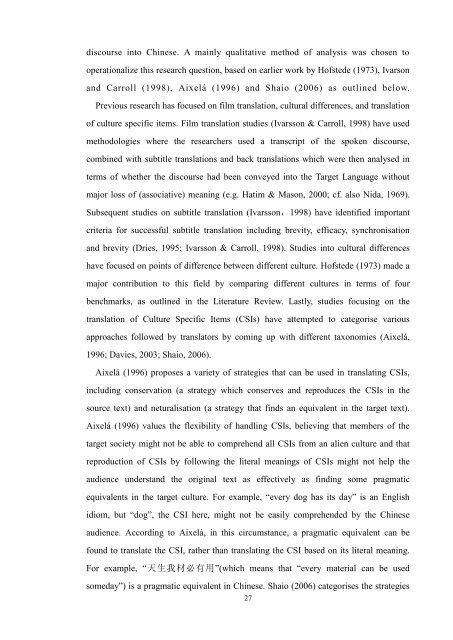View - Scholarly Commons Home
View - Scholarly Commons Home
View - Scholarly Commons Home
Create successful ePaper yourself
Turn your PDF publications into a flip-book with our unique Google optimized e-Paper software.
discourse into Chinese. A mainly qualitative method of analysis was chosen to<br />
operationalize this research question, based on earlier work by Hofstede (1973), Ivarson<br />
and Carroll (1998), Aixelá (1996) and Shaio (2006) as outlined below.<br />
Previous research has focused on film translation, cultural differences, and translation<br />
of culture specific items. Film translation studies (Ivarsson & Carroll, 1998) have used<br />
methodologies where the researchers used a transcript of the spoken discourse,<br />
combined with subtitle translations and back translations which were then analysed in<br />
terms of whether the discourse had been conveyed into the Target Language without<br />
major loss of (associative) meaning (e.g. Hatim & Mason, 2000; cf. also Nida, 1969).<br />
Subsequent studies on subtitle translation (Ivarsson,1998) have identified important<br />
criteria for successful subtitle translation including brevity, efficacy, synchronisation<br />
and brevity (Dries, 1995; Ivarsson & Carroll, 1998). Studies into cultural differences<br />
have focused on points of difference between different culture. Hofstede (1973) made a<br />
major contribution to this field by comparing different cultures in terms of four<br />
benchmarks, as outlined in the Literature Review. Lastly, studies focusing on the<br />
translation of Culture Specific Items (CSIs) have attempted to categorise various<br />
approaches followed by translators by coming up with different taxonomies (Aixelá,<br />
1996; Davies, 2003; Shaio, 2006).<br />
Aixelá (1996) proposes a variety of strategies that can be used in translating CSIs,<br />
including conservation (a strategy which conserves and reproduces the CSIs in the<br />
source text) and neturalisation (a strategy that finds an equivalent in the target text).<br />
Aixelá (1996) values the flexibility of handling CSIs, believing that members of the<br />
target society might not be able to comprehend all CSIs from an alien culture and that<br />
reproduction of CSIs by following the literal meanings of CSIs might not help the<br />
audience understand the original text as effectively as finding some pragmatic<br />
equivalents in the target culture. For example, “every dog has its day” is an English<br />
idiom, but “dog”, the CSI here, might not be easily comprehended by the Chinese<br />
audience. According to Aixelá, in this circumstance, a pragmatic equivalent can be<br />
found to translate the CSI, rather than translating the CSI based on its literal meaning.<br />
For example, “天生我材必有用”(which means that “every material can be used<br />
someday”) is a pragmatic equivalent in Chinese. Shaio (2006) categorises the strategies<br />
27

















